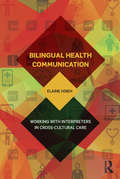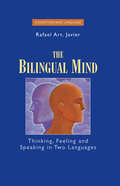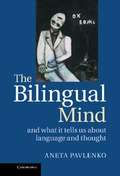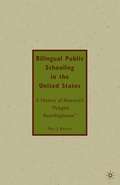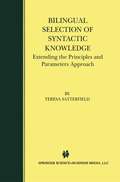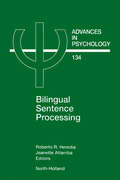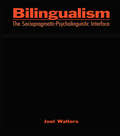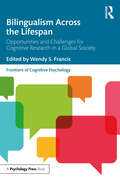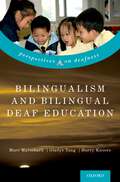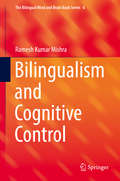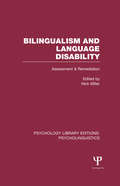- Table View
- List View
Bilingual Health Communication: Working with Interpreters in Cross-Cultural Care
by Elaine HsiehThis book examines interpreter-mediated medical encounters and focuses primarily on the phenomenon of bilingual health care. It highlights the interactive and coordinated nature of interpreter-mediated interactions. Elaine Hsieh has put together over 15 hours of interpreter-mediated medical encounters, interview data with 26 interpreters from 17 different cultures/languages, 39 health care providers from 5 clinical specialties, and surveys of 293 providers from 5 clinical specialties. The depth and richness of the data allows for the presentation of a theoretical framework that is not restricted by language combination or clinical contexts. This will be the first book of its kind that includes not only interpreters’ perspectives but also the needs and perspectives of providers from various clinical specialties. Bilingual Health Communication presents an opportunity to lay out a new theoretical framework related to bilingual health care and connects the latest findings from multiple disciplines. This volume presents future research directions that promise development for both theory and practice in the field.
Bilingual Learners and Social Equity: Critical Approaches to Systemic Functional Linguistics (Educational Linguistics #33)
by Ruth HarmanThis volume explores how educators conceptualized and implemented critical approaches to systemic functional linguistics that support bilingual students in appropriating and challenging dominant knowledge domains in K-16 contexts. The researchers exhibit a shared commitment to enacting a culturally sustaining SFL praxis that validates multilingual meaning making, pushes against social inequity, and fosters creative re-mixing of available semiotic resources. It should prove a valuable resource for students, teachers and researchers interested in applied linguistics, education and critical theory.
The Bilingual Mind: Thinking, Feeling and Speaking in Two Languages (Cognition and Language: A Series in Psycholinguistics)
by Rafael Art JavierThis book fills a critical gap in the cross-cultural literature by illuminating the bilingual experience in both its social and clinical contexts. Rafael Javier makes a convincing, empirically founded case for what he terms the bilingual mind, with its own particular approach to cognition, memory, and emotional and social development. Using this framework, he provides answers to important questions about the way bilingualism affects cognition and development.
The Bilingual Mind (PDF): And What It Tells Us About Language And Thought
by Aneta PavlenkoIf languages influence the way we think, do bilinguals think differently in their respective languages? And if languages do not affect thought, why do bilinguals often perceive such influence? For many years these questions remained unanswered because the research on language and thought had focused solely on the monolingual mind. Bilinguals were either excluded from this research as 'unusual' or 'messy' subjects, or treated as representative speakers of their first languages. Only recently did bi- and multilinguals become research participants in their own right. Pavlenko considers the socio-political circumstances that led to the monolingual status quo and shows how the invisibility of bilingual participants compromised the validity and reliability of findings in the study of language and cognition. She then shifts attention to the bilingual turn in the field and examines its contributions to the understanding of the human mind.
Bilingual Parent Participation in a Divided School Community (Routledge Critical Studies in Multilingualism)
by Julia Menard-WarwickThis volume theorizes parent participation in a bilingual school community in California, unpacking broader issues around language ideologies, language and power, and parent collaboration in diverse educational contexts. Highlighting data from a two-year ethnographic study of the school community, the book grounds this discussion in theories of discourse and bilingualism, with a focus on translanguaging and translingual practice. The volume points to a range of challenges and questions posed by the parents’ efforts to unite as a single school community, including linguistic inequality, cultural divides, and differing implicit beliefs on language. The book documents these efforts as a means to demonstrate the ways in which monolingual practices are reinforced in these settings, despite best efforts, but also as a point of departure to discuss implications and a way forward for parent collaboration in bilingual school communities more generally. Offering a nuanced portrait of the impact of parent collaboration in bilingual school communities, this volume will be of particular interest to graduate students and scholars in language education, applied linguistics, bilingualism, and sociolinguistics.
Bilingual Parent Participation in a Divided School Community (Routledge Critical Studies in Multilingualism)
by Julia Menard-WarwickThis volume theorizes parent participation in a bilingual school community in California, unpacking broader issues around language ideologies, language and power, and parent collaboration in diverse educational contexts. Highlighting data from a two-year ethnographic study of the school community, the book grounds this discussion in theories of discourse and bilingualism, with a focus on translanguaging and translingual practice. The volume points to a range of challenges and questions posed by the parents’ efforts to unite as a single school community, including linguistic inequality, cultural divides, and differing implicit beliefs on language. The book documents these efforts as a means to demonstrate the ways in which monolingual practices are reinforced in these settings, despite best efforts, but also as a point of departure to discuss implications and a way forward for parent collaboration in bilingual school communities more generally. Offering a nuanced portrait of the impact of parent collaboration in bilingual school communities, this volume will be of particular interest to graduate students and scholars in language education, applied linguistics, bilingualism, and sociolinguistics.
Bilingual Public Schooling in the United States: A History of America's "Polyglot Boardinghouse"
by P. RamseyThis history of one of the most contentious educational issues in America examines bilingual instruction in the United States from the common school era to the recent federal involvement in the 1960s and 1970s. Drawing from school reports, student narratives, legal resources, policy documents, and other primary sources, the work teases out the underlying agendas and patterns in bilingual schooling during much of America s history. The study demonstrates clearly how the broader context - the cultural, intellectual, religious, demographic, economic, and political forces - shaped the contours of dual-language instruction in America between the 1840s and 1960s. Ramsey s work fills a crucial void in the educational literature and addresses not only historians, linguists, and bilingual scholars, but also policymakers and practitioners in the field.
Bilingual Selection of Syntactic Knowledge: Extending the Principles and Parameters Approach
by Teresa SatterfieldBilingual Selection of Syntactic Knowledge motivates a more formal approach in theoretical linguistics by investigating the parameters of syntactic variation and simultaneous acquisition of multiple languages. Taking the behavior of the Null Subject Parameter (NSP) across languages as an illustration, the book raises important questions concerning the adequacy of standard parameter-setting models in the face of compelling evidence from both mono- and bilingual child speech data. Teresa Satterfield argues convincingly that so-called `universal' premises guiding well-known parametric approaches greatly complicate attempts to construct an economical bilingual analysis. Further, she demonstrates the compatibility of more recent formulations in linguistic theory (i.e. the Minimalist Program) and studies on language learnability (Clark, 1992, 1993; Kapur, 1994) which present the view that while initially convincing, standard parameter models are potentially costly and less than effective in terms of monolinguals as well. Using Clark's application of the Genetic Algorithm as a point of departure, Bilingual Selection of Syntactic Knowledge describes a number of computational simulations. These simulations not only demonstrate the robustness of the GA-as-language-learner, they offer a more detailed account of the parameter-setting task confronting the bilingual child while also making more precise predictions regarding the process of syntactic knowledge.
Bilingual Sentence Processing (ISSN #Volume 134)
by Roberto Heredia J. AltarribaBilingual Sentence Processing
The Bilingual Text: History and Theory of Literary Self-Translation
by Jan Walsh Hokenson Marcella MunsonBilingual texts have been left outside the mainstream of both translation theory and literary history. Yet the tradition of the bilingual writer, moving between different sign systems and audiences to create a text in two languages, is a rich and venerable one, going back at least to the Middle Ages. The self-translated, bilingual text was commonplace in the mutlilingual world of medieval and early modern Europe, frequently bridging Latin and the vernaculars. While self-translation persisted among cultured elites, it diminished during the consolidation of the nation-states, in the long era of nationalistic monolingualism, only to resurge in the postcolonial era. The Bilingual Text makes a first step toward providing the fields of translation studies and comparative literature with a comprehensive account of literary self-translation in the West. It tracks the shifting paradigms of bilinguality across the centuries and addresses the urgent questions that the bilingual text raises for translation theorists today: Is each part of the bilingual text a separate, original creation or is each incomplete without the other? Is self-translation a unique genre? Can either version be split off into a single language or literary tradition? How can two linguistic versions of a text be fitted into standard models of foreign and domestic texts and cultures? Because such texts defeat standard categories of analysis, The Bilingual Text reverses the usual critical gaze, highlighting not dissimilarities but continuities across versions, allowing for dissimilarities within orders of correspondence, and englobing the literary as well as linguistic and cultural dimensions of the text. Emphasizing the arcs of historical change in concepts of language and translation that inform each case study, The Bilingual Text examines the perdurance of this phenomenon in Western societies and literatures.
The Bilingual Text: History and Theory of Literary Self-Translation
by Jan Walsh Hokenson Marcella MunsonBilingual texts have been left outside the mainstream of both translation theory and literary history. Yet the tradition of the bilingual writer, moving between different sign systems and audiences to create a text in two languages, is a rich and venerable one, going back at least to the Middle Ages. The self-translated, bilingual text was commonplace in the mutlilingual world of medieval and early modern Europe, frequently bridging Latin and the vernaculars. While self-translation persisted among cultured elites, it diminished during the consolidation of the nation-states, in the long era of nationalistic monolingualism, only to resurge in the postcolonial era. The Bilingual Text makes a first step toward providing the fields of translation studies and comparative literature with a comprehensive account of literary self-translation in the West. It tracks the shifting paradigms of bilinguality across the centuries and addresses the urgent questions that the bilingual text raises for translation theorists today: Is each part of the bilingual text a separate, original creation or is each incomplete without the other? Is self-translation a unique genre? Can either version be split off into a single language or literary tradition? How can two linguistic versions of a text be fitted into standard models of foreign and domestic texts and cultures? Because such texts defeat standard categories of analysis, The Bilingual Text reverses the usual critical gaze, highlighting not dissimilarities but continuities across versions, allowing for dissimilarities within orders of correspondence, and englobing the literary as well as linguistic and cultural dimensions of the text. Emphasizing the arcs of historical change in concepts of language and translation that inform each case study, The Bilingual Text examines the perdurance of this phenomenon in Western societies and literatures.
Bilingual Writers and Corpus Analysis (Routledge Studies in Applied Linguistics)
by David M. Palfreyman Nizar HabashThis innovative volume is one of the first to represent the usage of bilingual writers in both their languages, offering insight into language corpora as extremely valuable tools in contemporary applied linguistics research, and in turn, into how much of the world’s population operate daily. This book discusses one of the first examples of a bilingual writer corpus, the Zayed Arabic-English Bilingual Undergraduate Corpus (ZAEBUC), which includes writing by hundreds of students in two languages, with additional information about the writers and the texts. The result is a rich resource for research in multilingual use and learning of language. The book takes the reader through the design and use of such a corpus and illustrates the potential of this type of corpus with detailed studies that show how assessment, vocabulary, and discourse work across two very different languages. This volume will be of interest to scholars, policymakers, and educators in bilingualism, plurilingualism, language education, corpus design, and natural language processing.
Bilingual Writers and Corpus Analysis (Routledge Studies in Applied Linguistics)
by David M. Palfreyman Nizar HabashThis innovative volume is one of the first to represent the usage of bilingual writers in both their languages, offering insight into language corpora as extremely valuable tools in contemporary applied linguistics research, and in turn, into how much of the world’s population operate daily. This book discusses one of the first examples of a bilingual writer corpus, the Zayed Arabic-English Bilingual Undergraduate Corpus (ZAEBUC), which includes writing by hundreds of students in two languages, with additional information about the writers and the texts. The result is a rich resource for research in multilingual use and learning of language. The book takes the reader through the design and use of such a corpus and illustrates the potential of this type of corpus with detailed studies that show how assessment, vocabulary, and discourse work across two very different languages. This volume will be of interest to scholars, policymakers, and educators in bilingualism, plurilingualism, language education, corpus design, and natural language processing.
Bilingualer Unterricht im Fokus der Biologiedidaktik: Auswirkungen von Unterrichtssprache und -kontext auf Motivation und Wissenserwerb
by Petra DuskePetra Duske zeigt, dass sich bilingualer Fachunterricht zur Aufrechterhaltung der Schülermotivation im Sachfach und zum Erwerb vergleichbaren Wissens wie im deutschsprachigen Biologieunterricht eignet. Der Unterrichtskontext im Sinne einer thematischen Einbettung scheint eine untergeordnete Rolle für Motivation und Wissenserwerb zu spielen. Dies sind die Ergebnisse einer vergleichenden Untersuchung mit ca. 800 Schülerinnen und Schülern anhand eines bilingualen bzw. deutschsprachigen Moduls im Fach Biologie. Die Studie kann als Entscheidungshilfe für Lehrkräfte, Schulleitungen, Bildungsadministrationen, Schülerinnen und Schülern sowie deren Eltern bei der Einführung von oder Teilnahme an bilingualen Bildungsgängen dienen.
Bilingualism (Routledge Guides to Linguistics)
by Shahrzad MahootianBilingualism provides a concise and lively introduction to bilingualism as a social and linguistic phenomenon and explains its impact on individuals and on society. Addressing questions such as what it means to be bilingual, how one becomes bilingual, and how exposure to more than one language can hinder or enhance a child’s cognitive development, this book features: an introduction to the linguistic, sociolinguistic, and cognitive outcomes of bilingualism, including bilingual language acquisition, the grammar of language-mixing, the link between language choice and identity, and the value of maintaining and promoting bilingualism; up-to-date overviews of the prominent concerns and facts about bilingualism; activities and discussion questions which invite readers to consider their own perspectives on bilingualism and how it manifests in their own lives and communities; links to relevant videos and suggested further reading, including topical novels, short stories, and essays. Aimed at students with no background in linguistics, this book is essential reading for anyone studying bilingualism for the first time.
Bilingualism (Routledge Guides to Linguistics)
by Shahrzad MahootianBilingualism provides a concise and lively introduction to bilingualism as a social and linguistic phenomenon and explains its impact on individuals and on society. Addressing questions such as what it means to be bilingual, how one becomes bilingual, and how exposure to more than one language can hinder or enhance a child’s cognitive development, this book features: an introduction to the linguistic, sociolinguistic, and cognitive outcomes of bilingualism, including bilingual language acquisition, the grammar of language-mixing, the link between language choice and identity, and the value of maintaining and promoting bilingualism; up-to-date overviews of the prominent concerns and facts about bilingualism; activities and discussion questions which invite readers to consider their own perspectives on bilingualism and how it manifests in their own lives and communities; links to relevant videos and suggested further reading, including topical novels, short stories, and essays. Aimed at students with no background in linguistics, this book is essential reading for anyone studying bilingualism for the first time.
Bilingualism: The Sociopragmatic-Psycholinguistic Interface
by Joel WaltersIn the past 30 years, the study of bilingualism processing has been conducted independently by two fields, psycholinguistics and sociolinguistics. This volume merges these two fields, addressing one of the tough problems dividing researchers in bilingualism, conceptually as well as methodologically. Joel Walters proposes a new approach to bilingualism processing--the Sociopragmatic-Psycholinguistic (SPPL) Model--which presents language as a social phenomenon. The author accomplishes this by identifying and organizing evidence from a wide range of linguistic disciplines, merging sociopragmatics, discourse analysis, and ethnography with social cognition, psycholinguistics, and neuroscience. By extension, the author offers convincing explanations of how related fields can profit from a comprehensive bilingual processing model. As a result, Joel Walters delivers a well-organized, comprehensive model that is thought through at every level. This book appeals to graduate students, scholars in the fields of linguistics, bilingualism, second language acquisition, psycholinguistics, and sociolinguistics. It is useful to researchers for its comprehensiveness and methodological acumen and may be appropriate as a supplementary textbook for graduate-level courses in bilingualism or for seminars on similar topics.
Bilingualism: The Sociopragmatic-Psycholinguistic Interface
by Joel WaltersIn the past 30 years, the study of bilingualism processing has been conducted independently by two fields, psycholinguistics and sociolinguistics. This volume merges these two fields, addressing one of the tough problems dividing researchers in bilingualism, conceptually as well as methodologically. Joel Walters proposes a new approach to bilingualism processing--the Sociopragmatic-Psycholinguistic (SPPL) Model--which presents language as a social phenomenon. The author accomplishes this by identifying and organizing evidence from a wide range of linguistic disciplines, merging sociopragmatics, discourse analysis, and ethnography with social cognition, psycholinguistics, and neuroscience. By extension, the author offers convincing explanations of how related fields can profit from a comprehensive bilingual processing model. As a result, Joel Walters delivers a well-organized, comprehensive model that is thought through at every level. This book appeals to graduate students, scholars in the fields of linguistics, bilingualism, second language acquisition, psycholinguistics, and sociolinguistics. It is useful to researchers for its comprehensiveness and methodological acumen and may be appropriate as a supplementary textbook for graduate-level courses in bilingualism or for seminars on similar topics.
Bilingualism Across the Lifespan: Opportunities and Challenges for Cognitive Research in a Global Society (Frontiers of Cognitive Psychology)
by Wendy S. FrancisBilingualism Across the Lifespan explores the opportunities and challenges that are inherent in conducting cognitive research in an increasingly global and multilingual society. Divided into three sections, the book highlights the multifaceted and complex nature of bilingualism. The first section focuses on what every cognitive psychologist ought to know about bilingualism: the impact of bilingualism on cognition across the lifespan, the idea that bilinguals are not a special case, and the importance of bilingualism in cognitive research beyond language. The second section focuses on challenges inherent in bilingual research: diversity of bilingual experience, the assessment of proficiency, and finding matched comparison groups and materials. Finally, the book considers opportunities that are created when bilingualism is incorporated into the cognitive research enterprise. It illustrates how researchers of bilingualism leverage theory, methodology, and findings from single-language research, incorporate uniquely bilingual processes or representations, and target populations of bilinguals that help to establish universal properties. Bringing together leading international contributors, the book provides the reader with a better understanding of the nature of bilingualism and bilingual research as it relates to human cognition. It will be an essential read for all researchers and upper-level students of bilingualism and cognitive psychology more generally.
Bilingualism Across the Lifespan: Opportunities and Challenges for Cognitive Research in a Global Society (Frontiers of Cognitive Psychology)
by Wendy S. FrancisBilingualism Across the Lifespan explores the opportunities and challenges that are inherent in conducting cognitive research in an increasingly global and multilingual society. Divided into three sections, the book highlights the multifaceted and complex nature of bilingualism. The first section focuses on what every cognitive psychologist ought to know about bilingualism: the impact of bilingualism on cognition across the lifespan, the idea that bilinguals are not a special case, and the importance of bilingualism in cognitive research beyond language. The second section focuses on challenges inherent in bilingual research: diversity of bilingual experience, the assessment of proficiency, and finding matched comparison groups and materials. Finally, the book considers opportunities that are created when bilingualism is incorporated into the cognitive research enterprise. It illustrates how researchers of bilingualism leverage theory, methodology, and findings from single-language research, incorporate uniquely bilingual processes or representations, and target populations of bilinguals that help to establish universal properties. Bringing together leading international contributors, the book provides the reader with a better understanding of the nature of bilingualism and bilingual research as it relates to human cognition. It will be an essential read for all researchers and upper-level students of bilingualism and cognitive psychology more generally.
Bilingualism and Bilingual Deaf Education (Perspectives on Deafness)
by Marc Marschark, Gladys Tang and Harry KnoorsIn Bilingualism and Bilingual Deaf Education, volume editors Marc Marschark, Gladys Tang, and Harry Knoors bring together diverse issues and evidence in two related domains: bilingualism among deaf learners - in sign language and the written/spoken vernacular - and bilingual deaf education. The volume examines each issue with regard to language acquisition, language functioning, social-emotional functioning, and academic outcomes. It considers bilingualism and bilingual deaf education within the contexts of mainstream education of deaf and hard-of-hearing students in regular schools, placement in special schools and programs for the deaf, and co-enrollment programs, which are designed to give deaf students the best of both educational worlds. The volume offers both literature reviews and new findings across disciplines from neuropsychology to child development and from linguistics to cognitive psychology. With a focus on evidence-based practice, contributors consider recent investigations into bilingualism and bilingual programming in different educational contexts and in different countries that may have different models of using spoken and signed languages as well as different cultural expectations. The 18 chapters establish shared understandings of what are meant by "bilingualism," "bilingual education," and "co-enrollment programming," examine their foundations and outcomes, and chart directions for future research in this multidisciplinary area. Chapters are divided into three sections: Linguistic, Cognitive, and Social Foundations; Education and Bilingual Education; and Co-Enrollment Settings. Chapters in each section pay particular attention to causal and outcome factors related to the acquisition and use of these two languages by deaf learners of different ages. The impact of bilingualism and bilingual deaf education in these domains is considered through quantitative and qualitative investigations, bringing into focus not only common educational, psychological, and linguistic variables, but also expectations and reactions of the stakeholders in bilingual programming: parents, teachers, schools, and the deaf and hearing students themselves.
Bilingualism and Bilingual Deaf Education (Perspectives on Deafness)
by Marc Marschark Gladys Tang Harry KnoorsIn Bilingualism and Bilingual Deaf Education, volume editors Marc Marschark, Gladys Tang, and Harry Knoors bring together diverse issues and evidence in two related domains: bilingualism among deaf learners - in sign language and the written/spoken vernacular - and bilingual deaf education. The volume examines each issue with regard to language acquisition, language functioning, social-emotional functioning, and academic outcomes. It considers bilingualism and bilingual deaf education within the contexts of mainstream education of deaf and hard-of-hearing students in regular schools, placement in special schools and programs for the deaf, and co-enrollment programs, which are designed to give deaf students the best of both educational worlds. The volume offers both literature reviews and new findings across disciplines from neuropsychology to child development and from linguistics to cognitive psychology. With a focus on evidence-based practice, contributors consider recent investigations into bilingualism and bilingual programming in different educational contexts and in different countries that may have different models of using spoken and signed languages as well as different cultural expectations. The 18 chapters establish shared understandings of what are meant by "bilingualism," "bilingual education," and "co-enrollment programming," examine their foundations and outcomes, and chart directions for future research in this multidisciplinary area. Chapters are divided into three sections: Linguistic, Cognitive, and Social Foundations; Education and Bilingual Education; and Co-Enrollment Settings. Chapters in each section pay particular attention to causal and outcome factors related to the acquisition and use of these two languages by deaf learners of different ages. The impact of bilingualism and bilingual deaf education in these domains is considered through quantitative and qualitative investigations, bringing into focus not only common educational, psychological, and linguistic variables, but also expectations and reactions of the stakeholders in bilingual programming: parents, teachers, schools, and the deaf and hearing students themselves.
Bilingualism and Bilingual Education: Politics, Policies and Practices in a Globalized Society
by B. Gloria JohannessenThis volume presents a multinational perspective on the juxtaposition of language and politics. Bringing together an international group of authors, it offers theoretical and historical constructs on bilingualism and bilingual education. It highlights the sociocultural complexities of bilingualism in societies where indigenous and other languages coexist with colonial dominant and other prestigious immigrant languages. It underlines the linguistic diaspora and expansion of English as the world’s lingua franca and their impact on indigenous and other minority languages. Finally, it features models of language teaching and teacher education. This book challenges the existent global conditions of non-dominant languages and furthers the discourse on language politics and policies. It does so by pointing out the need to change the bilingual/multilingual educational paradigm across nations and all levels of educational systems.
Bilingualism and Cognitive Control (The Bilingual Mind and Brain Book Series #6)
by Ramesh Kumar MishraThis thought-provoking monograph makes a multidisciplinary case for bilingualism as a possible enhancer of executive function, particularly cognitive control. Its central focus is the cognitive operations of the bilingual brain in processing two languages and whether they afford the brain a greater edge on neuroplasticity—in short, a cognitive advantage. Major issues and controversies in the debate are analyzed from cognitive neuroscience, psycholinguistic, and integrative perspectives, with attention paid to commonly and rarely studied domains at work in bilingual processing. The author also pinpoints future areas for improved research such as recognizing the diversity of bilingualism, not simply in languages spoken but also in social context, as seen among immigrants and refugees. Included in the coverage: The evolution of bilingualism.What goes on in a bilingual mind? The core cognitive mechanisms.Cognitive advantage of bilingualism and its criticisms.Neuroscience of bilingualism.Bilingualism, context, and control.Attention, vision, and control in bilinguals. With its cogent takes on ongoing questions and emerging issues, Bilingualism and Cognitive Control is of immediate interest to bilingual researchers and practitioners interested in understanding the behavioral aspects and neurobiology of bilingualism and the dynamic character of the bilingual/multilingual/second language learner’s mind, as well as the growing number of advanced undergraduate and graduate students interested in the psychology/psycholinguistics of bilingualism, bilingual cognitive psychology, cognitive science, and cognitive neuroscience.
Bilingualism and Language Disability: Assessment and Remediation (Psychology Library Editions: Psycholinguistics)
by Nick MillerSociety is becoming increasingly multi-lingual and this presents monolingual professionals, particularly those in special education and speech pathology, with severe problems. Is the language delay in a child from a bilingual environment a result of this background or is there a specific speech problem? Is a child’s poor performance in school due to his problems of coping with two languages, or does he need remedial teaching? Originally published in 1984, this book is not concerned with second language learning, but with speech and learning difficulties in bilingual children as they are presented to remedial teachers, psychologists and speech therapists. To this end the first group of specially written articles deals with the patterns of language usage in bilingual communities and the social and psychological factors which shape these patterns; with processes in normal bilingual language acquisition; and with the relationship between cognitive development and growing up with two languages. Management issues and methods involved in helping children with language problems are also tackled: they include taking case histories, family liaison, counselling, bilingual programmes, mother tongue teaching, curriculum development and the training of personnel to work in the bilingual-bicultural field. This book provided a great deal of practical help, in a field that was relatively new at the time of writing, and helped to enlighten readers on the issues involved and assist in crystalising thought and directing future research.
